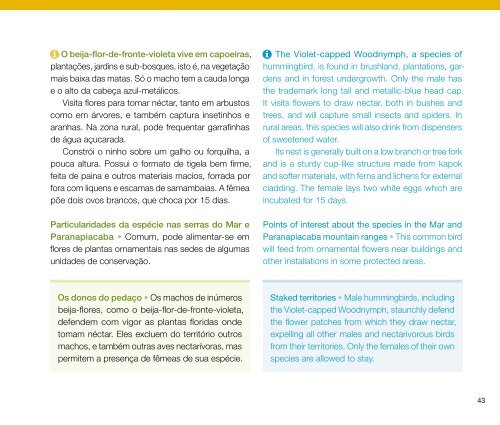Guia de aves Mata Atlântica Paulista - Secretaria do Meio Ambiente
Guia de aves Mata Atlântica Paulista - Secretaria do Meio Ambiente
Guia de aves Mata Atlântica Paulista - Secretaria do Meio Ambiente
Create successful ePaper yourself
Turn your PDF publications into a flip-book with our unique Google optimized e-Paper software.
O beija-flor-<strong>de</strong>-fronte-violeta vive em capoeiras,<br />
plantações, jardins e sub-bosques, isto é, na vegetação<br />
mais baixa das matas. Só o macho tem a cauda longa<br />
e o alto da cabeça azul-metálicos.<br />
Visita flores para tomar néctar, tanto em arbustos<br />
como em árvores, e também captura insetinhos e<br />
aranhas. Na zona rural, po<strong>de</strong> frequentar garrafinhas<br />
<strong>de</strong> água açucarada.<br />
Constrói o ninho sobre um galho ou forquilha, a<br />
pouca altura. Possui o formato <strong>de</strong> tigela bem firme,<br />
feita <strong>de</strong> paina e outros materiais macios, forrada por<br />
fora com liquens e escamas <strong>de</strong> samambaias. A fêmea<br />
põe <strong>do</strong>is ovos brancos, que choca por 15 dias.<br />
Particularida<strong>de</strong>s da espécie nas serras <strong>do</strong> Mar e<br />
Pa ranapiacaba • Comum, po<strong>de</strong> alimentar-se em<br />
flores <strong>de</strong> plantas ornamentais nas se<strong>de</strong>s <strong>de</strong> algumas<br />
unida<strong>de</strong>s <strong>de</strong> conservação.<br />
The Violet-capped Woodnymph, a species of<br />
hummingbird, is found in brushland, plantations, gar<strong>de</strong>ns<br />
and in forest un<strong>de</strong>rgrowth. Only the male has<br />
the tra<strong>de</strong>mark long tail and metallic-blue head cap.<br />
It visits flowers to draw nectar, both in bushes and<br />
trees, and will capture small insects and spi<strong>de</strong>rs. In<br />
rural areas, this species will also drink from dispensers<br />
of sweetened water.<br />
Its nest is generally built on a low branch or tree fork<br />
and is a sturdy cup-like structure ma<strong>de</strong> from kapok<br />
and softer materials, with ferns and lichens for external<br />
cladding. The female lays two white eggs which are<br />
incubated for 15 days.<br />
Points of interest about the species in the Mar and<br />
Paranapiacaba mountain ranges • this common bird<br />
will feed from ornamental flowers near buildings and<br />
other installations in some protected areas.<br />
Os <strong>do</strong>nos <strong>do</strong> pedaço • Os machos <strong>de</strong> inúmeros<br />
beija-flores, como o beija-flor-<strong>de</strong>-fronte-violeta,<br />
<strong>de</strong>fen<strong>de</strong>m com vigor as plantas floridas on<strong>de</strong><br />
tomam néctar. Eles excluem <strong>do</strong> território outros<br />
machos, e também outras <strong>aves</strong> nectarívoras, mas<br />
permitem a presença <strong>de</strong> fêmeas <strong>de</strong> sua espécie.<br />
Staked territories • Male hummingbirds, including<br />
the Violet-capped Woodnymph, staunchly <strong>de</strong>fend<br />
the flower patches from which they draw nectar,<br />
expelling all other males and nectarivorous birds<br />
from their territories. Only the females of their own<br />
species are allowed to stay.<br />
43

















